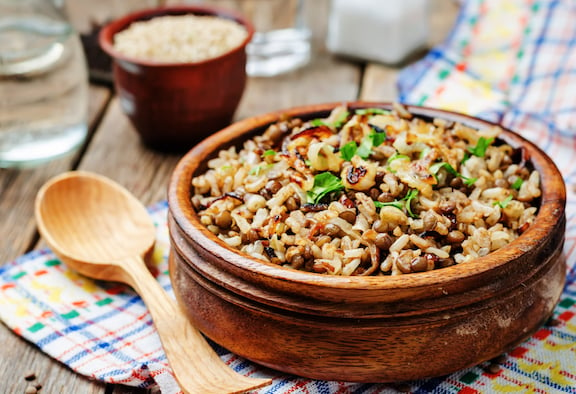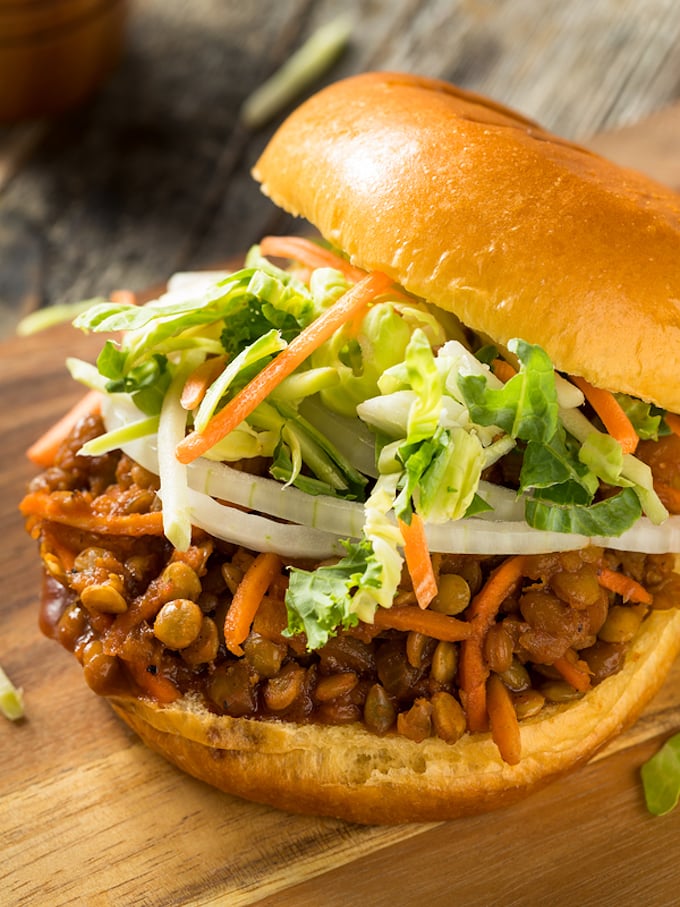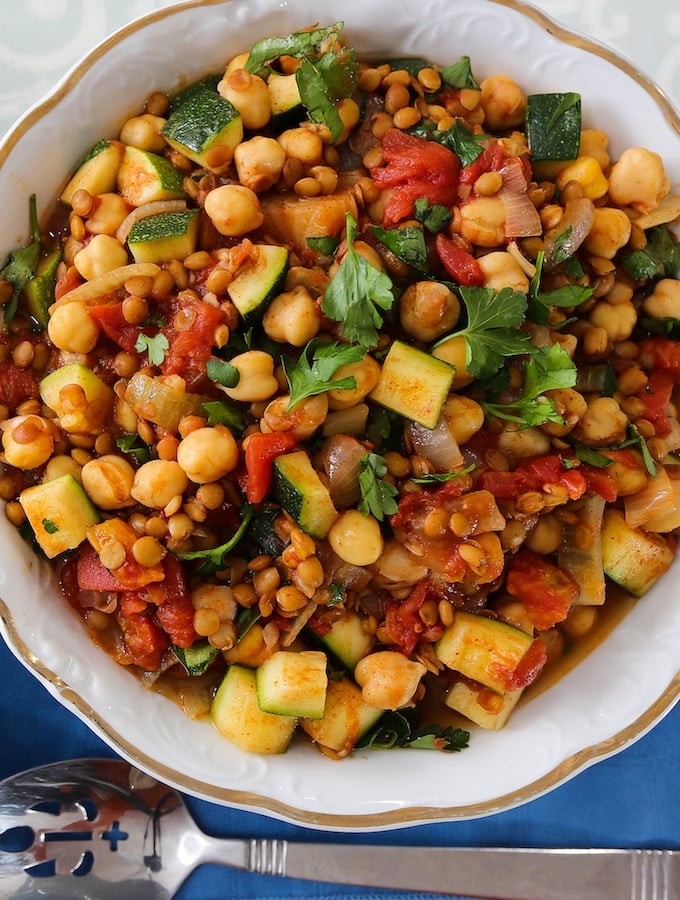Lentils are one of the most widely accessible, affordable sources of high-quality protein, to say nothing of their versatility when it comes to cooking. This guide to lentils has all the info you need on the common varieties, along with cooking tips and recipes.

More than just a hill of beans, lentils are some of the most nutritious, abundant, and diverse legumes are grown all around the world and are a beloved ingredient in many cuisines.
A Brief History of Lentils
Thought to be one of the oldest legumes and earliest cultivated crops, lentils have sustained humans and animals for well over 8,000 years.
Evidence of the earliest domesticated lentils has been found on the banks of the Euphrates River, preserved in fossils, in what is now northern Syria.
While they were regarded as food for the poor in Ancient Rome, it was quite the opposite case in Egypt around that same time, where lentils were buried alongside royals for sentience in the afterlife.
Lentils even make a cameo in the bible, in the Genesis story of brothers Jacob and Esau. Esau, the firstborn, sells his birthright to Jacob for some lentil stew. That should tell you something about the true value of these abundant beans.
Common Lentil Varieties
While only a handful of lentils can be found at most grocery stores in the US, there are more than 50 varieties grown around the world. These are some of the most popular lentils you’re likely to encounter while shopping in North American markets:

Brown lentils: Mild in flavor, subtly earthy, tender, and yet surprisingly meaty, brown lentils are the most popular type found in the U.S. They work well as a standalone side dish but can also be cooked longer to create a thick soup or stew.

Green lentils: Used interchangeably with brown lentils, green lentils have very similar flavor and cooking properties. If anything, they may be slightly firmer when cooked.

Red lentils: Mildly earthy, red lentils are often used in Indian and Middle Eastern dishes, often spiked with curry and other bold seasonings. They cook quickly to a fairly mushy consistency, making them fitting for dals, soups, and stews.

Black (Beluga) lentils: Named for their striking resemblance to beluga caviar, these lentils are small, rounded, and luxuriously jet-black in color. Their flavor is similar to black beans; earthy and full-bodied.

French (Le Puy) lentils: One of the most naturally flavorful lentils on the market, French (otherwise known as Le Puy) lentils have a slightly peppery taste and beautiful mottled grey-green color. They’re prized for use in salads because they hold their shape better than most other varieties. As a result, French lentils are also some of the most expensive.
Buying and Storing Lentils
Lentils are often found in bulk bins at very reasonable prices. Some varieties, especially brown and red lentils, are commonly found among the one-pound bags of grains and legumes (in cellophane bags) in well-stocked supermarkets.
Expect to pay $1 to 4 per pound for red, green, and brown lentils, and up to $6 to 8 per pound for black and French lentils. Look for less common varieties in online sources.
Dried lentils can be stored at room temperature, in an air-tight container, almost indefinitely. If you’ve had them in the pantry for a year or more, they may take longer to cook since they continue to lose moisture over time.

Use lentils as a high-protein bed for vegetable dishes in place of grains
Seen here: Classic Roasted Root Vegetables with Lots of Variations
How to Cook Lentils
Before turning on the stove, sift through your lentils to make sure there aren’t any small stones, twigs, or other foreign objects. Even packaged lentils can include some “extras” since it’s very hard for machines to detect these tiny additions that might have been picked up in the field.
One of the benefits of cooking with lentils versus other beans is that they don’t need to be soaked in advance. They cook quickly, straight from their dried state.
Cover lentils with at least 2 inches of fresh water in a large pot. Bring to a slow boil, then and simmer gently but steadily over medium-low heat. You don’t need an exact amount of water, but make sure they have plenty of room in which to simmer.
The amount of time needed for cooking will vary depending on the variety, ranging from 20 minutes (or less) for red lentils, to 35 minutes for most of the other varieties.
Keep a close eye on the pot and test periodically for doneness. It’s veasy to overcook lentils, so err on the side of caution if you want them to keep their shape, especially to use in pilafs or salads.
For lentils that are being cooked separately in this manner, drain thoroughly and rinse with cold water to stop the cooking process. Use right away, or store cooked lentils in an airtight container in the fridge for a few days.
Most recipes for lentil soups and stews call for them to be cooked right in the broth along with other ingredients, so there’s no harm if they get a little overcooked.
More cooking tips
- Yield: 1 cup uncooked lentils will yield about 2½ cooked, which can vary slightly according to variety.
- When it comes to red lentils, they’re meant to get mushy, so no worries on that front.
- Salt and acidic ingredients. such as vinegar and lemon juice, toughen their skins, so wait until lentils are tender before adding them.
- You can freeze cooked lentils, though they do tend to be a bit mushier when thawed.
What about canned lentils?
You always have the option of using canned lentils, because why not? Better to use canned lentils than no lentils if you’re pressed for time.
Sometimes saving even 20 or 25 minutes can be crucial when it comes to getting dinner on the table. The organic brands tend to be firmer and less salty. A 15-ounce can contains between 1½ and 1¾ cups cooked lentils, depending on how much liquid there is.

Lentil Nutrition Notes
Touted as an excellent source of complete protein, few other foods can compete with the impressive stats of lentils. Fiber is another big part of what makes these little legumes such vital foods, enhancing satiety and improving digestion.
Lentils are naturally gluten-free, low in fat, and boast exceptionally low glycemic index values.
Potassium, folate, iron, and manganese are some of the most abundant vitamins and minerals found in lentils, but that’s just the start.
Different types of lentils do vary slightly in their nutrient content, but they’re all smart choices for a whole foods diet. Here’s a complete look at the nutrition profile of lentils.
Lentils are also beneficial to the environment. Their roots promote nitrogen-producing bacteria which enriches, rather than depletes, the soil in which they’re grown.
 Vegan Sausage and Lentils with Yellow Rice
Vegan Sausage and Lentils with Yellow Rice
Recipes and Serving Suggestions
Dal: Also spelled dahl, daal, or dhal, this essential Indian dish is a thick soup or stew, typically made with red lentils and bright spices.
There are more types of dal than there are days of the year, but some of the most popular are: masoor dal, dal dhokli, tadka dal, dal makhani, navratan dal, among many more. Here’s our recipe for Red Lentil Dal and Rice Bowls.

Easy curries: Lentils and curry seasonings have a natural affinity for one another. Try Curried Lentils and Spinach over mashed potatoes for a delicious change of pace from grains.

Classic lentil and rice combos: Global dishes combining lentils with rice make hearty, filling everyday fare. The widely known Middle Eastern dish known as Mujaddarah.

Lentils with pasta: For one classic example, Italian Pasta and Lentils (Pasta e Lenticchie) is an easy everyday kind of dish.

Salad: It doesn’t take much to create a brilliant lentil salad. Black Lentil Salad with Peppers and Olives is quite a showstopper that can be a main or side dish. Use a half cup or so of cooked lentils to embellish your cool Buddha Bowls as well.

Simple Lentil and Tomato Salad: This hearty yet simple lentil and tomato salad can be enjoyed in its basic form, or embellished with any of the optional add-ins listed in the recipe.

Vegan burgers and sloppy joes: For those who like a veggie burger made with grains and legumes, Red Lentil and Quinoa Burgers will hit the spot.

If you’re craving a more unconventional change of pace, BBQ-Flavored Lentil Sloppy Joes are nicely spiced and sure to liven up your next outdoor meal or everyday dinner.
Meatballs: You’d never even know that lentils were involved in these hearty Vegan Lentil Meatballs. While any bean can work, lentils are always an affordable, tasty option that never disappoints. This is a great way to sneak more legumes past picky eaters.

Taco and burrito filling: It’s surprisingly easy to transform a handful of lentils into a hearty plant-based protein for tortilla specialties and sandwiches. Use lentils to make Super-Easy Vegan Lentil Tacos, Vegan Lentil and Back Bean Burritos, and more.

Soup, naturally: Lentil soups are a dime a dozen, but here’s one that gives you several ways to vary the standard recipe: Basic Lentil Soup with Tasty Variations. And for red lentils, you’d be hard-pressed to do better than Curry Coconut Red Lentil Soup.

Moroccan Lentil and Chickpea Soup (Harira): This showcases a compatible duo of legumes. It can be served all year round, but is especially appealing as a transitional early fall soup, using fresh tomatoes.
Pasta sauce: Amp up pasta dishes with red sauce with lentils for some extra protein power. Lentil Bolognese is a hearty sauce to serve over pasta, zucchini noodles, or farro. Or, try the Sicilian classic, Pasta with Hearty Lentil and Spinach Sauce.

Two-Legume Combo: Lentils pair with their larger legume cousins (aka beans) in a variety of recipes. For example, Cinnamon-Spiced Chickpea and Lentil Stew and Quick Lentil and Kidney Bean Curry.

Holiday centerpiece: When you want a showstopping dish for Thanksgiving, Christmas, or any holiday, lentils should have a place at the table too. Beluga Lentil-Stuffed Delicata Squash with Cashew Raita is a mouthful, in the best way possible. So is our Vegan Shepherd’s Pie with Lentils & Mushrooms.
Lentil Caviar: Living up to their name, Beluga lentils do indeed make a convincing vegan caviar, perfect for spooning over blini.
See more of this site’s Good Food Guides.
Contributed by Hannah Kaminsky: Hannah has developed an international following for her delicious recipes and mouthwatering food photography at the award-winning blog BitterSweet. Passionate about big flavors and simple techniques, she’s the author of Vegan Desserts, Vegan à la Mode, Easy as Vegan Pie, Real Food, Really Fast, Sweet Vegan Treats, The Student Vegan Cookbook, Super Vegan Scoops, and The Everyday Vegan Cheat Sheet Pan. Visit Hannah at BittersweetBlog.com.

Leave a Reply